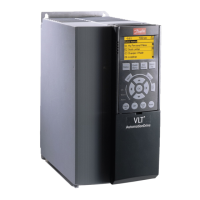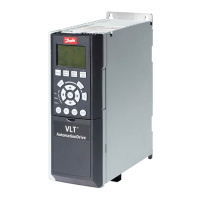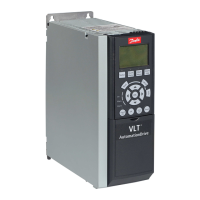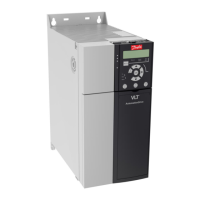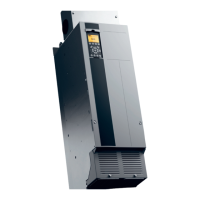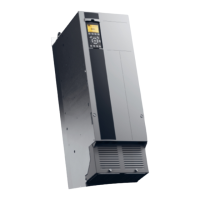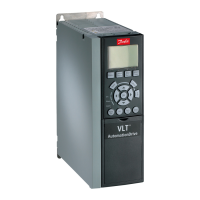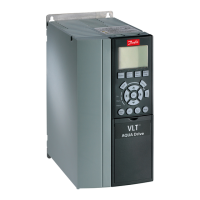Illustration 3.41 Installation to Achieve a Stopping Category 0
(EN 60204-1) with Safety Cat. 3/PL “d” (ISO 13849-1) or SIL 2 (EN
62061).
1 Safety relay (cat. 3, PL d or SIL2
2 Emergency stop button
3 Reset button
4 Short-circuit protected cable (if not inside installation IP54
cabinet)
Table 3.21 Legend toIllustration 3.41
Safe Stop Commissioning Test
After installation and before first operation, perform a
commissioning test of the installation making use of safe
stop. Moreover, perform the test after each modification of
the installation.
Example with STO
A safety relay evaluates the E-Stop button signals and
triggers an STO function on the frequency converter in the
event of an activation of the E-Stop button (See
Illustration 3.42). This safety function corresponds to a
category 0 stop (uncontrolled stop) in accordance with IEC
60204-1. If the function is triggered during operation, the
motor will run down in an uncontrolled manner. The
power to the motor is safely removed, so that no further
movement is possible. It is not necessary to monitor plant
at a standstill. If an external force effect is to be
anticipated, additional measures should be provided to
safely prevent any potential movement (e.g. mechanical
brakes).
NOTE
For all applications with Safe Stop it is important that short
circuit in the wiring to T37 can be excluded. This can be
done as described in EN ISO 13849-2 D4 by the use of
protected wiring, (shielded or segregated).
Example with SS1
SS1 correspond to a controlled stop, stop category 1
according to IEC 60204-1 (see Illustration 3.43). When
activating the safety function a normal controlled stop will
be performed. This can be activated through terminal 27.
After the safe delay time has expired on the external safety
module, the STO will be triggered and terminal 37 will be
set low. Ramp down will be performed as configured in
the frequency converter. If the frequency converter is not
stopped after the safe delay time the activation of STO will
coast the frequency converter.
NOTE
When using the SS1 function, the brake ramp of the
frequency converter is not monitored with respect to
safety.
Example with Category 4/PL e application
Where the safety control system design requires two
channels for the STO function to achieve Category 4/PL e,
one channel can be implemented by Safe Stop T37 (STO)
and the other by a contactor, which may be connected in
either the frequency converter input or output power
circuits and controlled by the Safety relay (see
Illustration 3.44). The contactor must be monitored through
an auxiliary guided contact, and connected to the reset
input of the Safety Relay.
Paralleling of Safe Stop input the one Safety Relay
Safe Stop inputs T37 (STO) may be connected directly
together if it is required to control multiple frequency
converters from the same control line via one Safety Relay
(see Illustration 3.45). Connecting inputs together increases
the probability of a fault in the unsafe direction, since a
fault in one frequency converter might result in all
frequency converters becoming enabled. The probability of
a fault for T37 is so low, that the resulting probability still
meets the requirements for SIL2.
Introduction
VLT
®
AutomationDrive FC 300 Design Guide, 0.25-75 kW
MG33BE02 - VLT
®
is a registered Danfoss trademark 55
3
3
http://www.RSPSupply.com/p-21462-Danfoss-131B8966-VLT-Automation-VT-Drive-VFD-FC301-230V-5-HP.aspx

